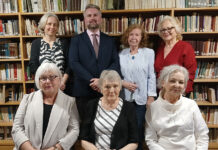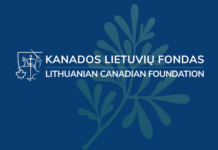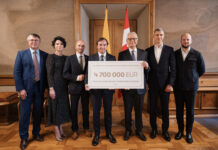
Aistė and Augustinas Žemaičiai continue their trip through Canada in their search for Lithuanian heritage sites.
Lithuanians we met during the last leg of our trip through the prairies told us we were the first Lithuanians they had met, and if they had read about us on www.gabaleliailietuvos.lt, they’d add: “We never thought you’d come here, so far from everything!“


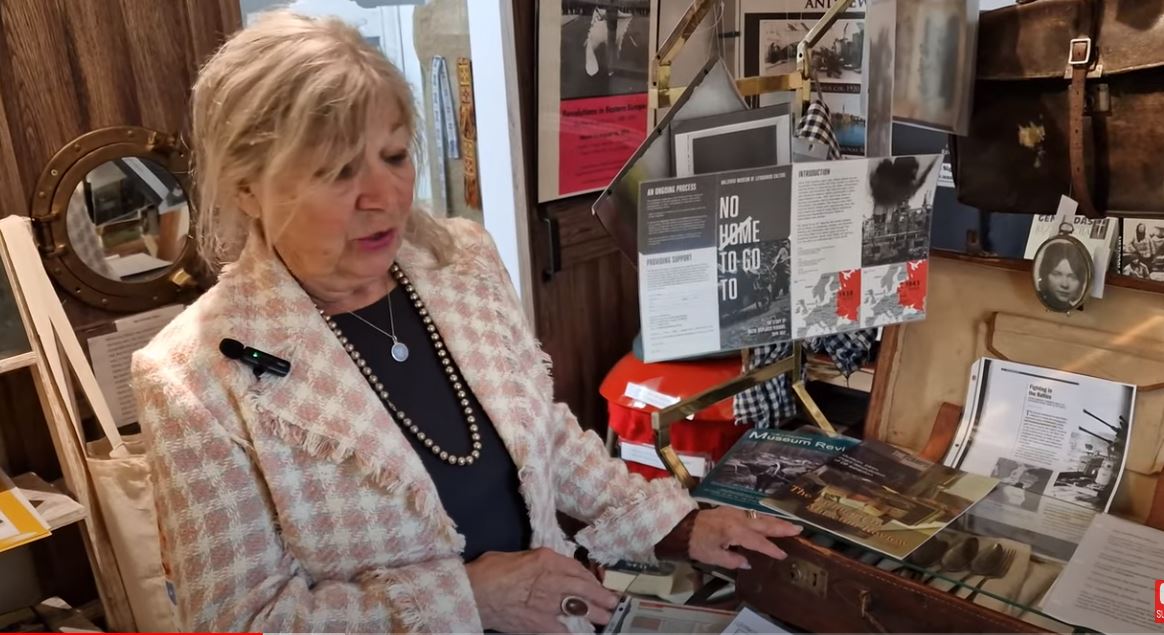
Driving through the Canadian prairies took us to the farthest Lithuanian outposts in the world. The founders and their descendents are long gone – deceased, moved elsewhere or no longer active in any community. We gathered news about those places crumb by crumb from old newspaper articles, newcomers to those areas, or second hand from other researchers. The exception is the Lithuanian House in Edmonton, serving as a chapel as needed, and still in use – in fact I spoke there in 2022.

There is a place called Vilna in Alberta. It’s not named after Vilnius, but was probably established by Ukrainians, in whose language it is one of the words for freedom.
 From Calgary we turned east, travelling 1350 km to Winnipeg, then 700 more to Thunder Bay and another 700 km to the Canada-US border at Sault Ste Marie.
From Calgary we turned east, travelling 1350 km to Winnipeg, then 700 more to Thunder Bay and another 700 km to the Canada-US border at Sault Ste Marie.



Winnipeg was once the true Lithuanian heart of the Canadian prairies, with the only Lithuanian church in any province west of Ontario. There is still a Lithuanian community here, headed by Giles (Egidijus) Bugailiškis. He was an artchitectural heritage specialist with the city of Winnipeg until he retired, and has collected a substantial amount of information about Lithuanian locations, which he was happy to share.
Unfortunately, he is practically the only person left in the Lithuanian community there, with the closure of the Lithuanian church and club. Most of the books left by the old Lithuanians were passed on to him by their children and grandchildren, who could no longer read them. Until COVID he would host any Lithuanian gatherings, still about 20 people, but the tradition has fallen away since then.
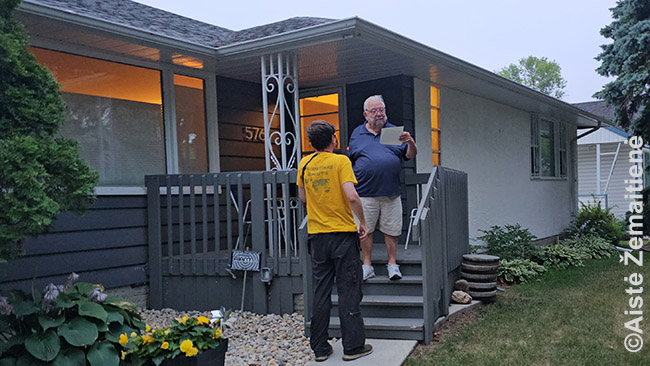
Giles said he never thought he’d be the central figure of the community. He grew up in Toronto, then studied in Winnipeg and meant to move, but never did. He was never overly interested in Lithuanian activities, but once his parents passed, he felt a need to preserve the community’s history.
And he certainly kept a lot of it. We photographed the titanic work of a Manitoban Lithuanian, Evaristas Fedaras, who had compiled all the articles printed about Winnipeg Lithuanians. What a perfect resource! Giles told us that the church was a one-priest parish: from 1953 to1957 Rev. J. Bertašius organized its contruction, hiring the architect Kulpa-Kulpavičius, and remained pastor until his death in 1999. After his funeral the local bishop closed the parish and sold the church, even though it had a sizeable Filipino congregation.
The construction of the church was not an easy task for Rev. Bertašius. There were never many Lithuanians in Winnipeg (e.g., 673 in 1961), and it was not a unified group. Many were “old” or first-wave immigrants, with more Communists among them than in any other Lithuanian community, and fewer DP’s. They had a Lithuanian Club, which is still marked with a corner stone. We read somewhere that the DP’s arriving there were horrified to see a portrait of Stalin in the club.
According to Giles Bugailiškis, the club members tried to sabotage the construction of the church. They would join the Building Committee just to interfere with the process. But they did not succeed. At one time the parish fared very well.
Apparently there was once a resort at Oak Point by Lake Manitoba, but we were unable to find it. Sources indicated that it was beside the CN railway station, but it was no longer there. Some of the locals remembered the station but not the resort. It had been purchased not by Winnipeg Lithuanians but by the Archdiocese of Kaunas during the Soviet occupation for Winnipeg Lithuanians, but once Lithuania became independent again and the religious freedom retstored, the property was returned to the Archdiocese and sold.
We found the Lithuanian Church and Club, but unfortunately they were located in the worst district of Winnipeg, and according to crime statistics, possibly the worst in Canada. There are fewer ghettos in Canada than in the US, but according to Giles, Winnipeg is the exception. The area was rife with drug-users, and taking pictures of the cornerstone of the club and the Lithuanian features of the church was awkward.
Giles showed us two other Lithuanian locations I didn’t know about. The first, a building marked “Alekno Block“ was built by a Lithuanian by the name of Alekna. He was a controversial figure, a funeral director and a politician, among other things, once taken to court for inappropriate funeral practice. His story is all in Giles’ papers.

Researching various newspapers, Giles found an article reporting that in 1967 the Lithuanians, Latvians and Estonians planted a ring of saplings in Assiniboine Park to commemorate Canada’s centennial. He decided to find those trees, but the search took several years, even with the help of park staff. The trees were not marked in any way, so Giles took it upon himself to purchase a bench nearby with a plaque about the trees. We have entered the spot on the map at www.tikslasamerika.lt.

From Winnipeg we went east on a long and lonely road that Giles said he had never travelled. At first we thought we’d leave toward evening, and stay over somewhere on the road, but found out it wouldn’t be that simple. So we stayed over with Giles and rose early the next morning. The prairies gave way to forests, and 700 kilometres later we arrived at the city of Thunder Bay, known for its cold winters, on the shore of Lake Superior. There are is only one vestige of the Lithuanian community left here, just a surprisingly huge monument – a cement pillar with the Pensive Christ and a rock with the word “Lithuania” on it, and the images of the Columns of Gediminas and the Freedom Statue of Kaunas. One would expect something like that in a city with many Lithuanian residents, but it stands in the International Friendship Park among monuments of other nations, and its probably the most impressive of them all!
 We couldn’t find any old-time Lithuanians who could tell us about the monument, but it so happened that a truelithuania.com reader and our client, whom we are helping with his Lithuanian citizenship – 29-year-old Matas Senkus has been living in Thunder Bay for ten years and working as a surveyor. It was surprising to be able to speak with him in Lithuanian, as he is younger than we are and a descendent of DP’s. We spoke to him at length and even recorded an interview with him for our Youtube channel.
We couldn’t find any old-time Lithuanians who could tell us about the monument, but it so happened that a truelithuania.com reader and our client, whom we are helping with his Lithuanian citizenship – 29-year-old Matas Senkus has been living in Thunder Bay for ten years and working as a surveyor. It was surprising to be able to speak with him in Lithuanian, as he is younger than we are and a descendent of DP’s. We spoke to him at length and even recorded an interview with him for our Youtube channel.
That day his father Valentine Senkus had come to Thunder Bay from Hamilton, who had also been born in Canada. They told us some disturbing facts, for example that the Delhi Lithuanian church that we had visited in 2019 was now closed and renovated into a residential home, and its cross was taken to the Hill of Crosses at the St. John’s Cemetery in Mississauga. It was a crucial moment – because until the Delhi church was closed, most Lithuanian churches in Canada had Masses said in them, and now they were held in a minority of churches. The church in Hamilton, with its impressive stained glass windows depicting Lithuanian warriors no longer had a pastor, and only have Lithuanian Mass offered once a month by priests from Toronto. Most likely the Lithuanian club “Giedraitis“ in Hamilton will close soon and its property will have to be sold. The only Lithuanian restaurant – “Lokys” in Toronto is already closed. These sad corrections have already been made in our online maps.
After our short meeting we drove for 8 hours straight for 700 kilometres along the amazing shore of Lake Superior. We crossed from Canada to the US at Sault Ste. Marie, where there had also been a Lithuanian community. But we found no contacts or information about any Lithuanian sites. The same was true for Sudbury, another 300 km east, so we didn’t even stop there, as we still had a week of travel ahead of us in the US.
All the places we found traces of Lithuanians are on the map http://map.truelithuania.com/, in the encyclopedia Global True Lithuania, and True Lithuania on YouTube.




